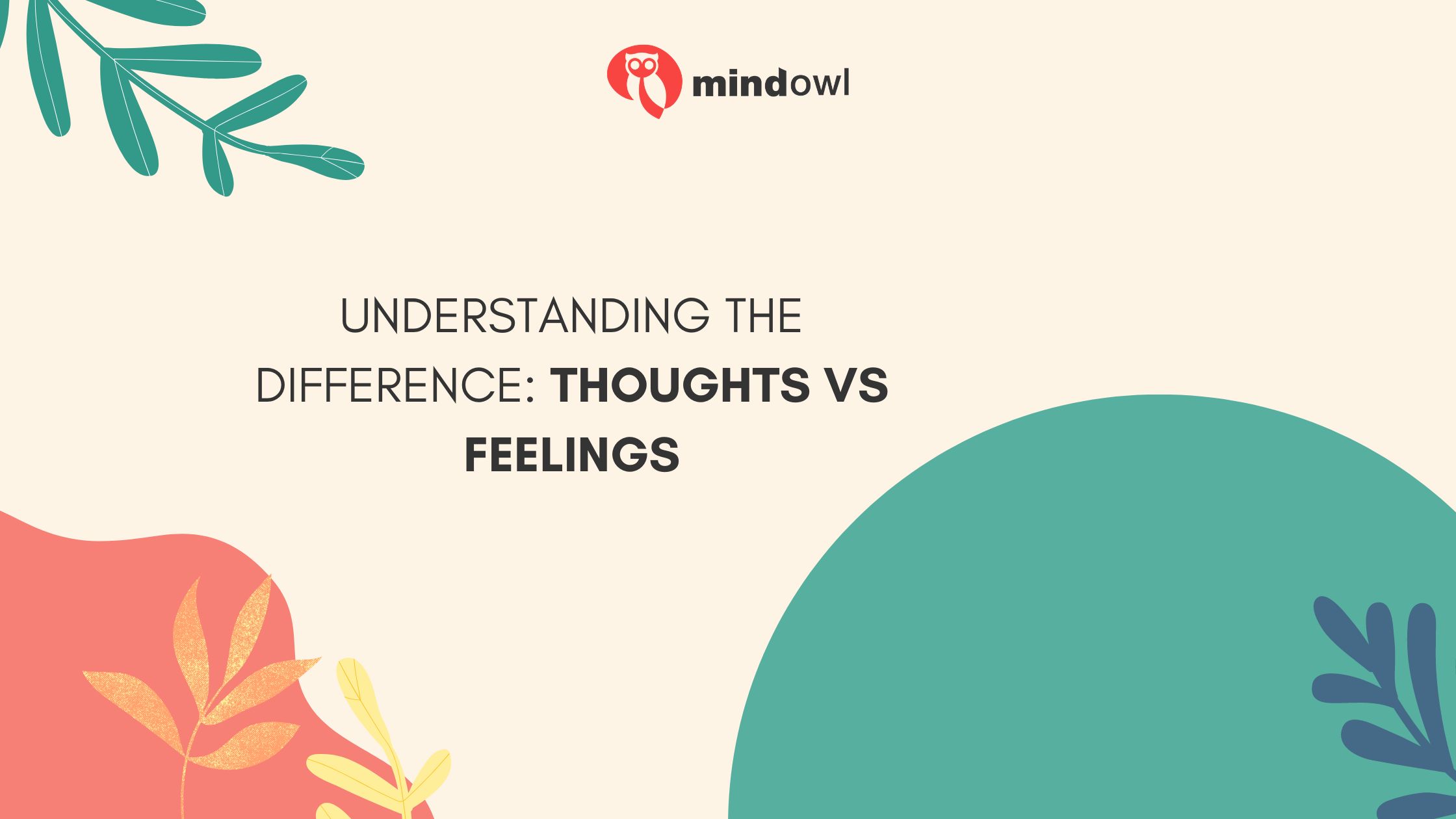It’s something that we all experience: feelings and thoughts. The two might seem interchangeable, but it’s essential to understand the difference between them to fully recognize the impact they have on our lives.
In this blog, we’ll explore how thoughts and feelings interact to create our own unique experience of life. We’ll explore the power of thought in decision-making; how it influences behavior, attitudes, and personality; and how feelings can both hinder and empower us. From considering how emotions shape perception to understanding the importance of self-awareness, this blog aims to bring insight into these complex relationships that make up the human experience.
Key Takeaways
- Thoughts are the mental processes and perceptions we create in our minds, while feelings are the emotional responses or sensations we experience within ourselves.
- Thoughts and feelings are closely connected, with thoughts influencing how we feel inside. Negative thoughts can lead to negative emotions, while positive thoughts can promote happiness and well-being.
- Our thoughts have a direct impact on our actions and behavior. Negative thoughts can hinder us from taking action or trying new things, while positive thoughts can motivate us to pursue our goals.
- It’s important to differentiate between thoughts and feelings for better self-awareness and managing our mental well-being. Techniques like mindfulness, cognitive restructuring, journaling, seeking support from others, and professional help can assist in observing and managing both our thoughts and feelings effectively.
Explaining Thoughts and Feelings

Thoughts can be defined as the mental processes and perceptions that occur in our minds, while feelings refer to the emotional responses or sensations we experience within ourselves.
Definition of thoughts
Thoughts are things we create in our minds. They can be about us, the world, or how we see a situation. Thoughts are not just ideas though. They also make up opinions and lead us to find solutions to problems.
In fact, thoughts often manage feelings because they help us understand them better. These mental work-outs give off energy and shape our view of life around us. We use these thoughts to make sense of what happens every day.
Definition of feelings
Feelings are things we sense inside us. They are our response to what happens around us. When something occurs, our brain gives a reaction. This reaction is called an emotion. Feelings like happiness, sadness, or anger rise from these emotions.
We feel different things each day. These feelings can change in a flash or last for a long time. How we view the world affects our feelings too. All these show that feelings play an important part in how we see and react to the world around us.
Connection between thoughts and feelings
Thoughts and feelings are tied together. They relate to each other in a way that affects how we act. Thoughts are creative and full of energy. They help us deal with our feelings and find answers to hard stuff.
Feelings, on the other hand, are things we sense inside our minds. But not all things we sense or feel are truly feelings! They can be false thoughts that make us feel upset or happy for no real reason.
The big link between thoughts and feelings is clear: How we think changes how we feel inside. These changes can then change how we behave towards people around us.
So next time you feel sad or angry, check your thoughts first! Maybe you’ll see it’s just bad thinking making you unhappy, not what’s happening around you.
The Role of Thoughts in Our Mental and Emotional State

Thoughts have a significant impact on our emotions and overall mental well-being.
How thoughts affect our emotions
Our thoughts have a big say in how we feel. You may think “I am bad at this” and start to feel sad. This shows that our emotion of sadness came from our thought. It is like our brain tells us how to feel based on what we think.
So, if we have happy thoughts, we will likely feel good inside. But if our thoughts are full of anger or distress, then we might feel upset or angry. This happens because feelings come first in response to the world around us but they can be shaped by what we think about them afterwards.
The power of negative thoughts
Negative thoughts are very strong. They can make us feel sad or scared. This is because our brain uses them to picture bad things that could happen. That makes us worry and feel stress. This harms our mental health. It makes it hard to enjoy life and get along with people.
Thinking negatively all the time can also lead to a decrease in the desire to do anything, causing feelings of uselessness. Programs like a boot camp in Arizona provide an alternative, focusing on helping teens overcome these challenges through structured emotional and behavioral support.
Moreover, these thoughts have a big role in dread, nervousness, sadness, and struggle dealing with stuff around us.
The impact of positive thinking
Positive thinking can change your life. It helps to cut down stress and makes you healthier. If you think in a positive way, it helps you see the good in any event.
You will also find that happy thoughts make people around you happier too. Your friends may start to enjoy being with you more if they see your joy.
Thinking of the good side of things has more power than we realize. It can even help people who have had serious health issues like brain injury feel better about their life! But the best thing is this – even if we sometimes feel sad or mad, having a general stance of positivity still does wonders for our health.
The CBT thoughts and feelings cycle
In the CBT model, thoughts and feelings link closely with actions. This forms a cycle. A thought can spark a feeling, which then leads to action. For example, the idea of “I can’t do this” might make you feel sad.
Then, you might stop trying new things because of these negative feelings. CBT helps crack this cycle by changing harmful thoughts like “I can’t”. It teaches people to think more like “I will try my best”.
By turning negative thinking into positive thinking lies the power of CBT in boosting mental health and wellbeing. The goal is to break bad cycles and start good ones!
Understanding Feelings
Feelings are distinct from thoughts and can be differentiated by their emotional nature.
What are feelings
Feelings are a part of our everyday lives. They are the way we experience and respond to the world around us. When we feel happy, sad, angry, or excited, those are all examples of feelings.
Feelings come from emotions, which are like signals in our bodies that tell us how we’re doing. Emotions happen automatically and can be influenced by things like our thoughts and experiences.
But feelings go beyond just the physical sensations – they involve having knowledge and awareness of what we’re feeling and why. It’s important to understand our feelings because they provide valuable information about ourselves and the world around us.
Differentiating feelings from thoughts
Feelings and thoughts are not the same. Thoughts are like ideas or things we think about in our minds. They involve cognitive processes and can be words, images, or even memories. On the other hand, feelings are conscious experiences that we have, such as being happy, sad, angry, or frustrated.
They are a type of conscious experience but not every conscious experience is a feeling.
Understanding the difference between thoughts and feelings is important for managing our mental well-being. By recognizing what is a thought and what is a feeling, we can navigate our emotions effectively and develop empathy towards others.
It allows us to better understand ourselves and the emotions we experience in various situations. So it’s helpful to know that when we say “I feel” followed by something like “angry,” it’s actually a feeling.
Common misconceptions about feelings
- Feelings are not the same as facts, and they don’t always reflect reality.
- Feelings can be influenced by past experiences and beliefs, but they are not always accurate indicators of the present situation.
- Feelings are not right or wrong; they are simply a response to our thoughts and interpretations.
- It is a misconception to believe that we should always trust our feelings without questioning or examining them.
- Feelings can change and fluctuate, so it’s important not to make decisions solely based on our current emotions.
- It is not true that some feelings are “good” while others are “bad.” All feelings serve a purpose and provide valuable information about our needs and experiences.
- It is incorrect to assume that we have no control over our feelings. While we may not be able to control initial emotional reactions, we can learn to manage and respond to them in healthier ways.
- Feeling a certain way does not mean that something is inherently wrong with us or that we need to suppress or ignore our emotions. It’s important to acknowledge and validate our feelings without judgment.
- Feeling multiple emotions at the same time is normal. It’s okay to experience both joy and sadness, anger and love, or any other combination of emotions simultaneously.
- Misconceptions about feelings can lead to misunderstanding, miscommunication, and unnecessary conflict in relationships. Taking the time to understand our own feelings and empathize with others’ emotions can help improve connection and understanding.
The Relationship Between Thoughts and Actions
Thoughts have a direct influence on our actions and behavior, shaping how we respond to situations and interact with others.
How thoughts can lead to actions
Thoughts have a powerful influence on our actions. When we have certain thoughts, they can lead us to behave in specific ways. For example, if we constantly think negative thoughts about ourselves, such as “I’m not good enough,” it can impact our self-esteem and make us less likely to take action or try new things.
On the other hand, positive thoughts like “I can do this” can motivate us to take steps towards achieving our goals. Our thoughts shape the way we perceive situations and determine how we respond to them.
Therefore, being aware of our thought patterns is crucial in understanding why we behave the way we do and making positive changes in our lives.
The influence of thoughts on behaviour
Our thoughts have a powerful influence on our behavior. When we think negative thoughts, it can lead to negative behaviors. For example, if we constantly tell ourselves that we’re not good enough, we might start avoiding new opportunities or giving up easily.
On the other hand, positive thoughts can lead to positive behaviors. If we believe in ourselves and think positively, we are more likely to take risks and achieve our goals.
Research has shown that our thoughts can directly affect the chemicals in our brain and impact how we feel and act. This is why cognitive-behavioral therapy (CBT) focuses on changing negative thought patterns to improve mental health outcomes.
How to Differentiate and Manage Thoughts and Feelings
– Techniques for observing and managing thoughts include mindfulness and cognitive restructuring.
– Strategies for identifying and processing feelings involve journaling, seeking support from others, and practicing self-reflection.
– If difficulties persist, it’s important to seek professional help from a therapist or psychologist.
Tools for observing and managing thoughts
Observing and managing our thoughts is crucial for maintaining our mental and emotional well-being. Here are some effective tools to help us with this:
- Thought records: These are helpful in identifying and challenging negative or unhelpful thoughts that contribute to unwanted feelings and behaviors. By writing down our thoughts, we can examine them more objectively and gain insight into their impact on our emotions.
- Mindfulness meditation: This practice involves focusing our attention on the present moment without judgment. It can help us observe our thoughts without getting caught up in them, allowing us to develop a greater sense of awareness and control.
- Cognitive restructuring: This technique involves challenging irrational or distorted thoughts and replacing them with more realistic and helpful ones. By questioning the evidence for our thoughts and considering alternative perspectives, we can change how they affect us.
- Positive affirmations: These are positive statements that we repeat to ourselves to counter negative self-talk or limiting beliefs. By consciously choosing uplifting and empowering words, we can reprogram our thinking patterns towards more positive and supportive ones. For those seeking structured support, an online IOP program can be an effective way to address mental health challenges from the comfort of your home.
- Journaling: Writing down our thoughts and feelings in a journal can provide an outlet for self-reflection. It allows us to explore our inner world, gain clarity, and release any pent-up emotions.
- Seeking support from others: Talking to a trusted friend, family member, or therapist can provide valuable insights and perspective on our thoughts. They can help challenge any negative patterns of thinking or offer guidance on managing difficult emotions.
Strategies for identifying and processing feelings
Strategies for identifying and processing feelings include:
- Developing self-awareness: Take the time to reflect on your emotions and understand what you are feeling. This can be done through journaling, talking to a trusted friend or family member, or seeking professional help from a therapist.
- Paying attention to physical sensations: Emotions often manifest in physical sensations in our bodies. Tune in to these sensations and use them as cues to identify what you may be feeling.
- Naming emotions: Give words to your emotions. Use a feelings chart or list of emotions to help you identify and label what you are experiencing. This can bring clarity and understanding to your emotional state.
- Challenging assumptions and beliefs: Sometimes our thoughts can influence the way we feel. Reflect on any negative thoughts or beliefs that may be influencing your emotions. Challenge these beliefs with more positive and balanced thinking.
- Practicing mindfulness: Mindfulness involves being fully present in the moment without judgment. This practice can help you observe your thoughts and feelings non-judgmentally, allowing you to process them in a healthier way.
- Seeking support: Don’t hesitate to reach out for support when needed. Talk to a trusted friend, family member, or therapist who can provide guidance and assistance in processing your feelings.
Seeking professional help when needed
If you find that managing your thoughts and feelings is challenging, it may be beneficial to seek professional help. Psychotherapists are trained in scientifically-proven techniques to assist individuals in developing healthier habits and coping mechanisms for their thoughts, emotions, and behaviors.
Psychiatrists and psychologists both have a deep understanding of how the brain works and can provide psychological interventions to treat mental illnesses. Additionally, therapists can assess the need for psychiatric medications if necessary.
Seeking support from friends and family is also important, as it can explain cultural differences in seeking professional help for mental health concerns. Remember that reaching out for professional assistance is a positive step towards improving your well-being.
Conclusion
In conclusion, understanding the difference between thoughts and feelings is essential for our well-being. Thoughts are ideas that we have in our mind, while feelings are emotions that we experience in our body.
By recognizing and managing both thoughts and feelings, we can better navigate our daily lives and take control of how they impact us. So remember, thoughts and feelings may be connected, but knowing their distinction empowers us to live a happier and more balanced life.
FAQs
1. What is the difference between thinking and feeling?
Thinking and feeling differ since thoughts are mental attitudes, while feelings are emotions that arise from those attitudes.
2. How can we become aware of our thoughts and feelings?
To be aware of your thoughts and feelings you need to get in touch with your inner self, take conscious control, so you can express what you feel or think with right words.
3. Is it wrong to judge people based on my feelings about them?
It’s not ‘wrong’ but could lead to misunderstandings as our feelings often guide us based on personal experiences, without being fair to another person.
4. Can disorders affect how we distinguish between thoughts and emotions?
Yes! People with autism or manic depressive disorder may experience difficulty distinguishing between their thoughts and their physiologically-induced ‘emotional’ responses like rage or depress moods.
5. Do genetics play a part in how we understand our own emotions?
Genetics play a role in regulating hormones which could shape one’s messiness of thinking versus distinct ‘feeling,’ thus possibly affecting the response towards sensory inputs from birth into adulthood.
6.Can I learn how someone else feels by listening to their words?
Listening attentively can help unlock understanding others’ feelings; for example when they say something like “I feel full of rage,” they’re using NVC (Nonviolent Communication) techniques designed to link individual needs & emotions together.
MindOwl Founder – My own struggles in life have led me to this path of understanding the human condition. I graduated with a bachelor’s degree in philosophy before completing a master’s degree in psychology at Regent’s University London. I then completed a postgraduate diploma in philosophical counselling before being trained in ACT (Acceptance and commitment therapy).
I’ve spent the last eight years studying the encounter of meditative practices with modern psychology.

